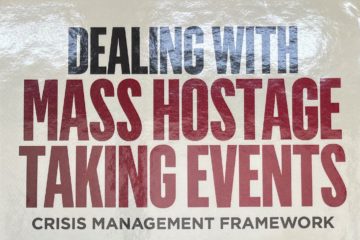Collaborating for the greater good
Our ability to make critical decisions in the heat of a crisis is influenced by many things and where we get it right, we are able to be agile among the chaos in leading people to safety.
As we operate in ever increasing complex environments our decision-making falls into three main areas, all of which are influenced by the perception of high and imminent danger, a collapsing time frame and our cognitive thought processes decreasing under the mounting stress.
In the ideal world we follow a more analytical approach where we gather information & intelligence; assess the threat/risk and then develop a working strategy; consider our legislative powers and policies; identify options & contingences and then act and review what has happened. At the heart of this cyclical decision-making process are our ethics and values as an organisation which gives us our underpinning principles. This gives us defensible decision making that can withstand future scrutiny where we have made deductive reasoning based on the information available.
However, without that knowledge and practice many under the increasing pressure resort to their intuitive ability to make decisions, which are based on that ‘gut feeling’ that is founded on our experience and learning. January 2009, Flight 1549 piloted by Captain Sully Sullenberger lost power in both engines following a mid-air bird strike shortly after departing LaGuardia Airport, NYC made an informed intuitive decision to land the aircraft on the Hudson River as he described: “One way of looking at this might be that for 42 years, I’ve been making small, regular deposits in this bank of experience, education and training. And on January 15, the balance was sufficient so that I could make a very large withdrawal.”
Where these pressures continue to escalate against a rapidly collapsing timeframe, some will succumb to their primal function in decision making where you see an acute stress reaction (Flight, Fight & Freeze response)[1] in the person where they move into survival mode and have no cognitive reasoning.
Understanding how we make decisions under pressure particularly during times of crises is important in how we in the humanitarian community learn the lessons from the emergency services. Through a number of different crises that were subjected to judicial review and also a changing threat landscape there was an acknowledgement that joint operability was vitally important in performing the core & primary function of the emergency services in saving life. There were some common themes relating to joint working where improvement was needed – JESIP (Joint Doctrine: the interoperability framework)[2] was established to address these issues:
- Challenges with initial command, control, and coordination activities on arrival at scene
- A requirement for common joint operational and command procedures
- Role of others, especially specialist resources and the reasons for their deployment, not well understood between services
- Challenges in the identification of those in charge at the scene leading to delays in planning response activity
- Misunderstandings when sharing incident information and differing risk thresholds not understood
There was a need to ensure that our initial multi-agency response to all incidents was more organised, structured, and practiced. The five principles of the joint doctrine are as follows:
- Co-locate – with other responders as soon as practicably possible at a single, safe, and easily identifiable location
- Communicate – using language which is clear and free from technical jargon and abbreviations
- Co-ordinate – by agreeing the lead organisation. Identify priorities, resources, capabilities, and limitations for effective response, including the timing of further meetings
- Jointly understand risk – by sharing information about the likelihood and potential impact of threats and hazards, to agree appropriate control measures
- Shared Situational Awareness – using the METHANE (Major Incident; Exact Location; Type of Incident; Hazards; Access; Number of Casualties & Emergency Services) and the Joint Decision Model
Perhaps the most important part of any decision-making model is our ability to access good quality information and intelligence. Shared Situational Awareness is achieved by sharing information and understanding between the involved organisations to build a stronger, multi-dimensional understanding of events, their implications, associated risks, and potential outcomes. Responders cannot assume others see things or say things in the same way, and a sustained effort is required to reach a common view and understanding of events, risks, and their implications. JESIP has instigated the use of a common model to help with the consistence and effective way of sharing incident information – METHANE.[3]
My experience in the response to the Afghan Crisis in 2021 highlighted areas for improvement in how we within the humanitarian world can learn from the joint doctrine adopted by the UK Emergency Services. Access to timely good quality information and intelligence is always essential in how we inform our decision-making to continue to keep our people safe and save life. The Saving Lives Together, or SLT, is a series of recommendations aimed at enhancing security collaboration between the United Nations, International Non-Governmental Organisations, and International Organisations (“SLT partner organisations”).
It recognizes the collectively experienced security threats and the importance of collaboration to ensure the safe delivery of humanitarian and development assistance.
The objective of SLT is to enhance the ability of partner organisations to make informed decisions and implement effective security arrangements to improve the safety and security of personnel and operations.[4]
One of the key elements of the SLT voluntary partnership is the sharing of good quality information, which requires commitment from all involved and which also helps to combat the dearth of misinformation that occurs around any crisis and can throw a curved ball into any decision-making process if the veracity of the information cannot be ascertained. Like any partnership that operates at both strategic and field level there are good and bad examples of partnership effectiveness, often born out of misaligned expectations or unrealistic expectations on the deliverables to foster teamwork in keeping people safe. This can impact on trust and can in some examples lead to a lack of engagement with the partnership.
Having been involved in training incident commanders within the Police Service and observing the early benefits of joint operability, it is clear to see the significant benefits in the joint doctrine of JESIP and it is one where, with advances in technology, the use of an app that members of each emergency service can follow these principles in a common language to provide an effective response to crises.
It is important that we occasionally subject partnerships to a ‘health check’ to see where improvements can be made and that all involved are contributing to the overarching vision. Research on the effectiveness of strategic partnerships derived a tool that was founded on six clear principles:[5]
- Recognise and Accept the Need for Partnership
- Develop Clarity and Realism of Purpose
- Ensure Commitment and Ownership
- Develop and Maintain Trust
- Create Clear and Robust Partnership Arrangements
- Monitor, Measure and Learn
Our ability to share vital information can sometimes be mired in bureaucracy, institutional barriers and is affected by not only resourcing but also technical jargon. Where this occurs as security professionals, we tend to resort to informal networks where we can share information and collaborate more effectively.
Collaboration is easy to talk about but often difficult to do. Perhaps now is the opportune time to take stock and review the partnerships within the humanitarian community to improve and better collaborate to save life. Working together with a common purpose, sharing resources and with access to good quality information significantly informs our decision-making and allows us to deliver the greater good to those caught up in conflict.
[1] Gepp, K & West, M (2021) What is the fight, flight or freeze response? Medical News Today accessed at: https://www.medicalnewstoday.com/articles/fight-flight-or-freeze-response
[2] JESIP – Working Together to Save Lives accessed at: https://www.jesip.org.uk/home
[3] https://www.jesip.org.uk/methane
[4] https://www.un.org/en/safety-and-security/partnerships
[5] Hardy, Brian & Hudson, Bob & Waddington, Eileen. (2003). Assessing Strategic Partnership: The Partnership Assessment Tool.


